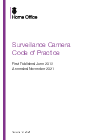An updated Code was laid before Parliament on 16 November 2021.
From:
Home Office
Published
22 November 2021
Last updated
29 November 2021 — See all updates
Documents

Amended Surveillance
Camera Code of Practice (accessible version)
HTML

Amended Surveillance Camera Code
of Practice
Ref: ISBN 978-1-5286-2983-6, E02688418Unnumbered act
paperPDF, 171
KB, 24 pages
Order a copy
This file may not be suitable for users of assistive technology.
Request an accessible format.

Surveillance Camera Code –
summary of consultation responses (accessible
version)
HTML

Surveillance Camera Code –
summary of consultation responses
PDF, 104
KB, 2 pages
This file may not be suitable for users of assistive technology.
Request an accessible format.

Explanatory memorandum to
the Surveillance Code of Practice (accessible
version)
HTML

Explanatory memorandum to the
Surveillance Code of Practice
PDF, 219
KB, 3 pages
This file may not be suitable for users of assistive technology.
Request an accessible format.
Details
An updated Surveillance Camera Code was laid before Parliament on
16 November 2021 pursuant to Section 31(3) of the Protection of
Freedoms Act 2012. Subject to receiving parliamentary approval,
the updated Code is due to come into effect on 12 January 2022.
Relevant authorities and users of surveillance camera systems
should continue to follow the current published
Code until the updated version comes into effect.
The government is committed to empowering the police to use
technologies like biometrics and surveillance cameras to protect
the public while maintaining their trust.
Simplifying and updating the Code is important in this context
because the Code provides guidance on the appropriate use of
surveillance camera systems by local authorities and the police.
We have updated references to subsequent legislation, in
particular the Data Protection Act 2018, and the Court of Appeal
judgment on live facial recognition in Bridges v South Wales
Police.
We have also shortened the text to make it easier for users to
follow. The updated Code does not place any additional burden on
users.
Before laying the Code before Parliament the Home Office
conducted a statutory consultation. Details of the consultation
and responses are in the accompanying document.




